|
|
 |
Fiche d'espèce de Copépode |
|
|
Calanoida ( Ordre ) |
|
|
|
Diaptomoidea ( Superfamille ) |
|
|
|
Tortanidae ( Famille ) |
|
|
|
Tortanus ( Genre ) |
|
|
|
Boreotortanus ( Sous-Genre ) |
|
|
| |
Tortanus (Boreotortanus) discaudatus (Thompson & Scott, 1897) (F,M) | |
| | | | | | | Syn.: | Corynura discaudata in Herdman & al., 1897 (p.80, figs.F,M);
Corynura bumpusii Wheeler, 1901 (p.184, Rem.F,M, figs.F,M);
Temora discaudatus Grice & Hart, 1962 (p.287; lapsus calami)
Tortanus discaudata : Hopcroft & al., 2009 (p.9, Table 3) | | | | Ref.: | | | Giesbrecht & Schmeil, 1898 (p.158); Sharpe, 1910 (p.414, Rem.); Willey, 1920 a (p.22); Esterly, 1924 (p.109, figs.F,M); Steuer, 1926 a (p.54, figs.F,M, chart); Rose, 1929 (p.46); Campbell, 1929 a (p.320, Rem.); Wilson, 1932 a (p.167, figs.F,M); M.W. Johnson, 1934 (p.182, figs. O, N, juv.); Davis, 1949 (p.66, figs.F,M); Brodsky, 1950 (1967) (p.429, figs.F,M); Anraku & Omori, 1963 (p.119, figs. mouth parts); Faber, 1966 (p.191, figs.N, Rem.: p.193, 199); Koga, 1968 (p.17, fig.: egg); Kos, 1976 (Vol. II, figs. F,M); Dawson & Knatz, 1980 (p.8, figs.F,M); Gardner & Szabo, 1982 (p.424, figs.F,M); Sazhina, 1985 (p.84, figs.N); Kos, 1984 (1985) (p.251, figs.F,M, Rem.); Ohtsuka, 1992 a (p.263); Ohtsuka & al., 1996b (p.153, figs.M); Chihara & Omori, 1997 (p.926, Pl.185: F,M); Ohtsuka & Reid, 1998 (p.776, figs.F,M, Rem.); Barthélémy & al., 1998 (p.721, genital area); Barthélémy, 1999 a (p.10, Fig.11, H); G. Harding, 2004 (p.18, figs.F,M); | 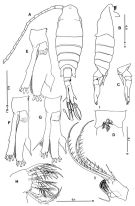 issued from : S. Ohtsuka & J.W. Reid in J. Crustacean Biol., 1998, 18 (4). [p.777, Fig.1]. Female (from NW Atlant.: Portland Harbor, Maine): A, habitus (dorsal); B, idem (lateral right side); C, pediger 5 and urosome (lateral left side); D, 2nd urosomite and anal somite (lateral right side); H, praecoxal arthrite of Mx1; I, Mxp. Female (from NE Pacif: Yes Bay to Seattle): E-G, anal somite and caudal rami (dorsal). Scale bars in mm. Nota: 2nd urosomite with patch of minute spinules on right posterolateral corner. Anal somite almost completely coalescing into caudal rami, bearing patch of minute spinules on right posterolateral corner. Caudal right ramus seta modified into sharply pointed process with swollen base, left seta stout, with setules along middle of posterior margin (caudal rami exhibiting variation). Praecoxal arthrite of Mx1 with 7 spinulose and 2 setulose setae, 1 minute naked seta, and spinous process. Mx2 with 2 setae on 1st coxal endite. Syncoxa of Mxp with 3 endites bearing 2, 2, 1 setae, respectively; basis unarmed; endopod 1-segmented (with suture subtly visible anteriorly), bearing 3 plumose setae along anterior margin and 1 posteriorly directed seta.
|
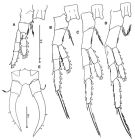 issued from : S. Ohtsuka & J.W. Reid in J. Crustacean Biol., 1998, 18 (4). [p.778, Fig.2]. Female (from NW Atlant.): A, P1 (anterior); B, P2 (anterior); C, P3 (anterior); D, P4 (anterior); E, P5 (anterior). Scale bars in mm. Nota: P5 3-segmented; both coxae and intercoxal sclerite dused to form common base; basis bearing minute plumose seta at point three-fourths along outer margin; endopod absent; exopod 1-segmented, curved smoothly inwardly, slightly asymmetrical, left longer than right, with inner margin smooth (not fringed with fine setules) and outer margin with 3 minute spines (indicated by arrows).
|
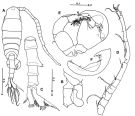 issued from : S. Ohtsuka & J.W. Reid in J. Crustacean Biol., 1998, 18 (4). [p.779, Fig.3]. Male (from NW Atlant.): A, habitus (dorsal); B, pediger 5 to 2nd urosomite (lateral right side); C, urosome (dorsal); D, right A1 (segments XV-XXVIII); E, P5 (anterior); F, exopod of right P5 (posterior). Scale bars in mm. Nota: Exopod 2-segmented, 1st segment with stout spiniform outer subterminal seta, 2nd segment with outer spine at midlength, 1 inner basal seta, and 1 short terminal seta (all indicated by arrows in fig.3E), fringed with setules along inner margin, with several longitudinal ridges terminally. 2nd urosomite segment produced lateralluy at right posterior corner, on which 2 hair-sensilla present. 3rd urosomal and anal somites slightly asymmetrical. Anal somite separate from caudal rami. P5 with both coxae fused to form compact common base; right leg with basis greatly expanded inwardly with 2 triangular processses along distal half of inner margin, each bearing minute seta at tip; left leg exopod 2-segmented, 2nd segment bearing outer spine at midlength, 1 inner basal seta and 1 short terminal seta (all indicated by arrows), fringed with setules of various lengths along inner margin, with several longitudinal ridges terminally.
|
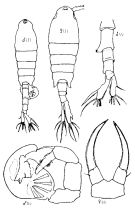 Issued from : K.A. Brodskii in Calanoida of the Far Eastern Seas and Polar Basin of the USSR. Opred. Fauna SSSR, 1950, 35 (Israel Program for Scientific Translations, Jerusalem, 1967) [p.430, Fig.304]. Female (from Sea of Japan): habitus (dorsal); S5, P5. Male: habitus (dorsal); urosome (venteral); S5, P5.
|
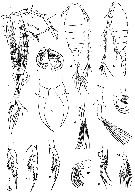 issued from : T. Mori in The pelagic Copepoda from the neighbouring waters of Japan, 1937 (1964). [Pl.52, Figs.1-14]. Female: 3, P5; 4, habitus (dorsal); 5, idem (lateral); 6, A2; 7, Md; 8, Mx1: 9, P2; 10, P3; 11, P4; 12, Mx2; 13, Mxp; 14, P1. Male: 1, habitus (dorsal); 2, P5. Nota: 2nd segment of the right leg of P5 with a stout thumb.
|
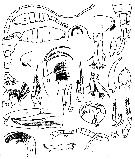 issued from : C.O. Esterly in Univ. Calif. Publs Zool., 1924, 26 (5). [p.110, Fig. P). Female (from San Francisco Bay):1, A1; 3, habitus (lateral); 6, anal segment and caudal rami (dorsal); 7, appendage on right ramus of caudal rami (dorsal); 8, last two thoracic segments and urosome (dorsal) with spermatophore; 10, forehead (lateral); 13, P1; 14, A2; 15, P1; ; 17, P5; 18, P5. Male: 2, habitus (lateral); 4, forehead (ventral); 5, idem (lateral); 9, last thoracic segment and urosome (dorsal); 11, Mx1; ; 12, Mxp; 16, caudal rami (dorsal); ; 19, region of geniculation of grasping A1; 20, P5; 21, Mx2; 22, right A1; 23, Md; 24, P3; 25, P4.
|
 issued from : G. Harding in Key to the adullt pelagic calanoid copepods found over the continental shelf of the Canadian Atlantic coast. Bedford Inst. Oceanogr., Dartmouth, Nova Scotia, 2004. [p.17]. Female & Male.
|
 issued from : R.-M. Barthélémy in Thèse Doct. Univ. Provence (Aix-Marseille I), 1999. [Fig.11, H]. Female (from Vancouver, Canada): H, external ventral view genital double-somite. go = genital operculum. Note thick anterior pad (arrow) of operculum. Scale bar: 0.010 mm.
|
 issued from : R.-M. Barthélémy, C. Cuoc, D. Defaye, M. Brunet & J. Mazza in Phil. Trans. R. Soc. Lond., B, 1998, 353. [p.733, Fig.63]. Schematic representation of external genital area in the species studied; Dashed line, limit of the anterior pad and lateral thickenings; shading, posterior pad; dots, genital operculum.
|
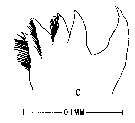 issued from : M. Anraku & M. Omori in Limnol. Oceanogr., 1963, 8. [p.122, Fig. 7, C] Tortanus discaudatus (from Woods Hole): Cutting edge of Md. Nota: The edge is composed of 1 small and 4 large teeth and has 1 small marginal spine and many fine hairs.
|
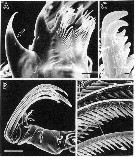 Issued from : S. Ohtsuka, M. Shimozu, A. Tanimura, M. Fukuchi, H. Hattori, H. Sasaki & O. Matsuda in Proc. NIPR Symp. Polar Biol., 1996, 9. [p.160, Fig.7, A-D]. Tortanus discaudatus Male (from Bering Strait): A, mandibular cutting edge, ventralmost tooth (arrowed); B, maxilla, praecoxal and coxal endites (arrowed); C, tips of endopodal setae of maxilla; D, middle part of terminal setae of maxilla. Scale bar = 10 µm (A, D); 100µm (B); 1 µm (C).
|
 Issued from : N.H. Marcus in Mar. Biol., 1990, 105. [p.415, Fig.2, d]. Egg of Tortanus discaudatus from sediment (coast of northern California, in February-April 1989). Egg diameter (µm); 107.1 ± 34.2 (N = 15) (sediments, February); 108.6 ± 24.5 (sediments, April). . Egg with flange (flange width ranged from 58 to 75 µm).
|
 discaudatus [p.252, Fig.16].jpg) Issued from : M.S. Kos in Issled. Fauny Morei, 1984 (1985), 30 (38). [p.252, Fig.16]. Female (from South Sakhalin Islands): 1, habitus (dorsal); 2, P1 ; 3, P3: 4, P4: 5, P2: 6, Mxp; 7, P5.
|
 discaudatus [p.253, Fig.17].jpg) Issued from : M.S. Kos in Issled. Fauny Morei, 1984 (1985), 30 (38). [p.253, Fig.17]. Male (from South Sakhalin Islands): 1, habitus (dorsal); 2, A1; 3, abdomen (dorsal); 4, A1 (detail segments 14-16); P5.
| | | | | Ref. compl.: | | | Bigelow, 1926 (p.294); W.H. Johnson, 1933 (p.1, vertical distribution vs. light); Sewell, 1948 (p.392); C.B. Wilson, 1950 (p.345); Deevey, 1956 (p.126, tab.IV); 1960 (p.5, Table II, annual abundance) ; M.W. Johnson, 1961 (p.311, Table 2); Lacroix & Bergeron, 1963 (p.59, Tableau III, IV); Northcote & al., 1964 (p.1069, Table II); Anraku, 1964 a (p.221, predation); Martin, 1965 (p.188); Faber, 1966 a (p.419, 420); Fleminger, 1967 a (tabl.1); Maclellan D.C., 1967 (p.101, 102: occurrence); Johnson M., 1967 (p.405, hatching); Vinogradov, 1968 (1970) (p.51); Itoh, 1970 a (p.1, tab.1, 2); Shih & al., 1971 (p.50, 153, 208); Ambler & Frost, 1974 (p.446, feeding behavior, animal diet); Peterson & Miller, 1975 (p.642, 650, Table 3, interannual abundance); 1976 (p.14, Table 1, 2, 3, abundance vs interannual variations); Gibson & Grice, 1977 (p.85, Table 1, copper pollution); Peterson & Miller, 1977 (p.717, Table 1, seasonal occurrence); Knatz, 1978 (p.68, Table 1, abundance, %); Conover, 1978 (p.66, 75, feeding); Mullin, 1979 (p.774, feeding); Herman & Dauphinee, 1980 (p.79, Table 2, length-biovolum); Mackas & Sefton, 1982 (p.1173, Table 1); Tremblay & Anderson, 1984 (p.7); Citarella, 1982 (p.791, 798: listing, frequency, Tableau II, V); Hargrave & al., 1985 (p.221, annual abundance); Harding & al., 1986 (p.952, Table 2, 3, 4, 6, fig.6, diel vertical movements); Citarella, 1989 (p.123, abundance); Coyle & al., 1990 (p.764); Marcus, 1990 (p.413, tab.1, 2, fig.2: egg); Shih & Marhue, 1991 (tab.2, 3); Kimmerer, 1993 (tab.2); Marcus & al., 1994 (p.154, Table 1, 3, distribution of eggs in sediments); Marcus, 1996 (p.144); Madhupratap & al., 1996 (p.77, table 2: resting eggs); Ohtsuka & al., 1995 (p.158: Rem.); Mauchline, 1998 (tab.20, 40, 48); Bragina, 1999 (p.196); Pinchuk & Paul, 2000 (p.4, table 1, % occurrence); Sameoto & al., 2002 (p.13); Park, W & al., 2004 (p.464, tab.1); CPR, 2004 (p.63, fig.190); Choi & al., 2005 (p.710: Tab.III); Manning & Bucklin, 2005 (p.233, Table 1); Papastephanou & al., 2006 (p.3078, Table 3); Hooff & Peterson, 2006 (p.2610); Humphrey, 2008 (p.84: Appendix A); Ohtsuka & al., 2008 (p.115, Table 5); Peterson, 2009 (p.73, Rem.: p 78); Galbraith, 2009 (pers. comm.); Turner & al., 2011 (p.1066, Table II, abundance 1998-2008); Bollens & al., 2011 (p.1358, Table III); Matsuno & al., 2011 (p.1349, Table 1, abundance vs years); Matsuno & al., 2012 (Table 2); DiBacco & al., 2012 (p.483, Table S1, ballast water transport); Moon & al., 2012 (p.1, Table 1); Mulyadi & Rumengan, 2012 (p.202, Rem.: p.204); Takahashi M. & al., 2012 (p.393, Table 2, water type index); Barton & al., 2013 (p.522, Table 1: metabolism, diapause, feeding mode, biogeo); Gusmao & al., 2013 (p.279, Table 3, sex-specific predation by fish); in CalCOFI regional list (MDO, Nov. 2013; M. Ohman, comm. pers.); Ohashi & al., 2013 (p.44, Table 1, Rem.); Questel & al., 2013 (p.23, Table 3, interannual abundance & biomass, 2008-2010, as discaudata); Coyle & al., 2014 (p.97, table 3) | | | | NZ: | 7 | | |
|
Carte de distribution de Tortanus (Boreotortanus) discaudatus par zones géographiques
|
| | | | | |  issued from : S. Ohtsuka & J.W. Reid in J. Crustacean Biol., 1998, 18 (4). [p.781, Fig.4]. issued from : S. Ohtsuka & J.W. Reid in J. Crustacean Biol., 1998, 18 (4). [p.781, Fig.4].
Horizontal distributions of several species in the genus Tortanus. |
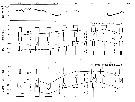 issued from : G.C. Harding, W.P. Vass, B.T. Hargrave & S. Pearre in Can. J. Fish. Aquat. Sci., 1986, 43 (5). [p.961, Fig.6]. issued from : G.C. Harding, W.P. Vass, B.T. Hargrave & S. Pearre in Can. J. Fish. Aquat. Sci., 1986, 43 (5). [p.961, Fig.6].
Depth-frequency diagrams and trap results of Tortanus discaudatus females and males during the 24-h study.
Incident radiation recorded on deck is indicated in the upper panel; arrows indicate sunset and sunrise. The actual number of individuals moving up or down into the traps at 8, 14, 21 and 28 m is indicated next to each arrow.
Trap deployment and retrieval time was set to coincide with the middle of adjacent horizontal, net-tow series.
The 25 and 75 % population quartiles are connected by broken lines and the population median is indicated by a black dot.
The number located inside each depth-frequency diagram (scale lower right) is the estimated number of individuals/ m3 in the water column during this series of horizontal net tows.
Sampling for eight and four periods, respectively, between 10:30 August 19 and 09:30 August 20, 1980, at St. Georges Bay, shallow marine embayment open on the north to Northumberland Strait and the southern Gulf of St. Lawrence.
Nota: Engine and deployment of mooring traps figured in Harding & al. (1987) and Harding & al. (1986). |
 issued from : B.T. Hargrave, G.C. Harding, K.F. Drinkwater, T.C. Lambert & W.G. Harrison in Mar. Ecol. Prog. Ser., 1985, 20. [p.227, Fig.7]. issued from : B.T. Hargrave, G.C. Harding, K.F. Drinkwater, T.C. Lambert & W.G. Harrison in Mar. Ecol. Prog. Ser., 1985, 20. [p.227, Fig.7].
Major species of zooplankton present at the central station in St. Georges Bay (45°45'N, 61°45'W) during 1977.
Nota: All zooplankton collections were made after sunset. The net towed obliquely throughout the water column (± 34 m in depth). |
 issued from : B.T. Hargrave, G.C. Harding, K.F. Drinkwater, T.C. Lambert & W.G. Harrison in Mar. Ecol. Prog. Ser., 1985, 20. [p.223, Fig.2]. issued from : B.T. Hargrave, G.C. Harding, K.F. Drinkwater, T.C. Lambert & W.G. Harrison in Mar. Ecol. Prog. Ser., 1985, 20. [p.223, Fig.2].
Seasonal profiles of water temperature and salinity in St. Georges Bay (45°45'N, 61°45'W) near the central station during 1977. |
 Issued from : M.R. Landry & V.L. Fagerness in Bull. Mar. Sc., 1988, 43 (3) [p.514, Table 3]. Issued from : M.R. Landry & V.L. Fagerness in Bull. Mar. Sc., 1988, 43 (3) [p.514, Table 3].
Comparison of size of body and appendages for seven species of marine copepods. Relationships among predation rates, selection patterns, swimming speed and orientation, and morphology of prey sensory and capture appendages. |
 Issued from : M.R. Landry & V.L. Fagerness in Bull. Mar. Sc., 1988, 43 (3) [p.520, Fig. 9]. Issued from : M.R. Landry & V.L. Fagerness in Bull. Mar. Sc., 1988, 43 (3) [p.520, Fig. 9].
Swimming speeds and directions of the copepods Tortanus discaudatus, Corycaeus anglicus, Oithona spinifera (= Oithona setigera). See also to Neocalanus cristatus, Euchaeta elongata (= Paraeuchaeta elongata), Calanus pacificus.
Swimming speeds measured as displacement over 2-s time intervals. 0° is up.
Study of the relationships among predation rates, selection patterns, swimming speed and orientation, and morphology of prey sensory and capture appendages.
The mean relative swimming speeds (S) of the predatory copepods and their preferred prey were calculated by the equation (Gerritsen, 1980).
S = [u + v)3 - [u - v)3 / 6uv.
u and v are respectively, the mean swimming speeds (mm/s) of the prey and the predator. |
 Issued from : M.R. Landry & V.L. Fagerness in Bull. Mar. Sc., 1988, 43 (3) [p.522-523, Table 5]. Issued from : M.R. Landry & V.L. Fagerness in Bull. Mar. Sc., 1988, 43 (3) [p.522-523, Table 5].
Comparison of the predatory characteristics of seven planktonic marine copepods.
F max is the mean, maximum clearance rate measured for the predator feeding on its preferred prey. Prey are developmental stages of common species of planktonic copepods.
F = female, M = male, C5 = stage 5. |
| | | | Loc: | | | Delaware Bay (outside), Narragansett Bay, Petttaquamscutt estuary, Rhode Island, Navesink River estuary, Long Island Sound, Woods Hole, Massachusetts Bay, G. of Maine, Bay of Fundy, Passamaquoddy Bay, off Nova Scotia E, Bedford Basin, St Georges Bay, Shédiac Bay, Northumberland Strait, G. of St. Lawrence, Bradelle Bank, Anticosti Is, Cap Breton Is., Strait of Belle Isle, Godthaab Fjord (W Greenland), James Bay, off SW Ireland (rare), China Seas (East China Sea, in W. Zhang & al., 2010), S Korea (Muan Bay), Japan, off SE Hokkaido, Okhotsk Sea, S Kuril Is., Bering Sea (also eastern and western neritic), Chukchi Sea, off NW Alaska, S Beaufort Sea, S & E Sakhalin Is., Alaska, Auke Bay, Icy Strait, British Columbia, Vancouver Is., Nitinat Lake, off Washington coast, Oregon (Yaquina, off Newport), San Francisco Bay & Estuary, California | | | | N: | 81 | | | | Lg.: | | | (45) F: 2,25-2; M: 2-1,75; (59) F: 2,5-1,8; M: 2-1,6; (141) F: 2,5-1,8; M: 1,65; (145) F: 1,8; M: 1,65; (280) F: 2,33-1,95; M: 1,36; (573) F: 2,25; (643) F: 2,75-1,43; M: 2,62-1,36; (762): F: 3,1-1,8 [Pacif.]; F: 2,25-2 [Atlant.]; M: 2,5-1,36 [Pacif.]; M: 2-1,75 [Atlant.]; (1259) F: 1,7; {F: 1,43-3,10; M: 1,36-2,62}.
(1259) F: 1,7 (total length), 1,04 (prosome length); A1 = 1,4 mm. (total length). | | | | Rem.: | néritique. Observé dans les ballasts des navires.
Voir aussi les remarques en anglais | | | Dernière mise à jour : 05/11/2021 | |
|
|
 Toute utilisation de ce site pour une publication sera mentionnée avec la référence suivante : Toute utilisation de ce site pour une publication sera mentionnée avec la référence suivante :
Razouls C., Desreumaux N., Kouwenberg J. et de Bovée F., 2005-2024. - Biodiversité des Copépodes planctoniques marins (morphologie, répartition géographique et données biologiques). Sorbonne Université, CNRS. Disponible sur http://copepodes.obs-banyuls.fr [Accédé le 20 avril 2024] © copyright 2005-2024 Sorbonne Université, CNRS
|
|
 |
 |














 discaudatus [p.252, Fig.16].jpg)
 discaudatus [p.253, Fig.17].jpg)






